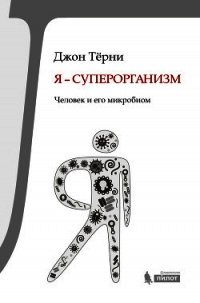Я – суперорганизм! Человек и его микробиом - Терни Джон (читать книги онлайн бесплатно без сокращение бесплатно TXT, FB2) 📗
Furusawa, Yukihiro, et al (2013). Commensal microbe-derived butyrate induces the differentiation of colonic regulatory T-cells. Nature, 504: 446–450.
Ganapathy, Vadivel, et al (2013). Transporters for short-chain fatty acids as the molecular link between colonic bacteria and the host. Current Opinion in Pharmacology, 13: 869–874.
Gest, Howard (2004). The Discovery of Microorganisms by Robert Hooke and Antoni van Leeuwenhoek, Fellows of the Royal Society. Notes and Records of the Royal Society of London, 58: 187–201.
Gevers, Dirk, et al (2014). The Treatment-Naive Microbiome in New-Onset Crohn’s Disease. Cell Host & Microbe. 15: 382–392.
Gibbons, Ann (2014). The Evolution of Diet. National Geographic, August.
Ginsberg, Alexandra, et al (2014). Synthetic Aesthetics: Investigating Synthetic Biology’s Designs on Nature. MIT Press.
Goldenberg, J., et al (2013). Probiotics for the prevention of Clostridium difficile associated diarrhea in adults and children. Cochrane Database Systematic Reviews. 5: CD006095.
Greenblum, Sharon, et al (2013). Towards a predictive systems-level model of the human microbiome: progress, challenges, and opportunities. Current Opinion in Biotechnology, 24:810–820.
Hagymasi, Kristina, et al (2014). Helicobacter pylori infection: New pathogenetic and clinical aspects. World Journal of Gastroenterology. 20: 6386–6399.
Hanage, William (2014). Microbiome science needs a healthy dose of scepticism. Nature, 512: 247–8.
Hickey, Roxana, et al (2012). Understanding vaginal microbiome complexity from an ecological perspective. Translational Research, 160: 267–282.
Hornick, R., et al (1970). Typhoid Fever: Pathogenesis and Immunologic Control. New England Journal of Medicine, 283: 739–746.
Hospodsky, D., et al (2014). Hand bacterial communities vary across two different human populations. Microbiology, 160:1144–1152.
House P. K., et al (2011). Predator cat odors activate sexual arousal pathways in brains of Toxoplasma gondii infected rats. PLoS One, 6: e23277.
Hsiao, Elaine, et al (2013). Microbiota Modulate Behavioral and Physiological Abnormalities Associated with Neurodevelopmental Disorders. Cell, 155: 1451–1463.
Human Microbiome Project Consortium (2012). A framework for human microbiome research. Nature, 486: 215–219.
Human Microbiome Project Consortium (2012). Structure, function and diversity of the healthy human microbiome. Nature, 486: 207–214.
Jackson, Mark (2006). Allergy: The History of a Modern Malady. Reaktion Books.
Jeurink, P., et al (2013). Human milk: a source of more life than we imagine. Beneficial Microbes, 4: 17–30.
Joyce, Christopher (2014). Soil Doctors Hit Pay Dirt In Manhattan’s Central Park. http://www.npr.org/2014/10/02/353066730.
Kankainen, M., et al (2009). Comparative genomic analysis of Lactobacillus rhamnosus GG reveals pili containing a human-mucus binding protein. Proceedings of the National Academy of Sciences. 106:17193–17198.
Kaptchuk, Ted, et al (2010). Placebos without Deception: A Randomised Controlled Trial in Irritable Bowel Syndrome. PloS One. 0015591.
Karlsson, F. H., et al (2014). Metagenomic Data Utilization and Analysis (MEDUSA) and Construction of a Global Gut Microbial Gene Catalogue. PLoS Comput Biol 10: e1003706.
Karr, Jonathan, et al (2012). A Whole-Cell Computational Model Predicts Phenotype from Genotype. Cell, 150:398–401.
Keeney, Kristie, et al (2014). Effects of Antibiotics on Human Microbiota and Subsequent Disease. Annual Review of Microbiology. 68: 217–35.
Khanna, Sahil, et al (2014). Clinical Evaluation of SER–90, a Rationally Designed, Oral Microbiome-Based Therapeutic for the Treatment of Recurrent Clostridium difficile. Доклад прочитан на конференции Американской гастроэнтерологической ассоциации. http://www.gastro.org/news/articles/2014/08/14/new-frontiers-of-fecal-microbiota-transplantation.
Klein, Jan (1982). Immunology: The Science of Self – Nonself Discrimination. John Wiley.
Koenig, Amy, et al (2010). Succession of microbial consortia in the developing infant gut microbiome. Proceedings of the National Academy of Sciences, 1000081107.
Kort, Remco, et al (2014). Shaping the oral microbiota through intimate kissing. Microbiome, 2:41.
Kotula, Jonathan, et al (2014). Programmable bacteria detect and record an environmental signal in the mammalian gut. Proceedings of the National Academy of Sciences, 111: 4838–4843.
Kroes, I. et al (1999). Bacterial diversity within the human subgingival crevice. Proceedings of the National Academy of Sciences. 96: 14547–52.
La Rosa, Patricio, et al (2014). Patterned progression of bacterial populations in the premature infant gut. Proceedings of the National Academy of Sciences, 111:12522–12527.
Lax, S., et al (2014). Longitudinal analysis of microbial interaction between humans and the indoor environment. Science, 345: 1048–1052.
Lecuit, Marc and Marc Eloit (2013). The human virome: new tools and new concepts. Trends in Microbiology, 21: 510–515.
Lederberg, Joshua (2000). Infectious History. Science, 288: 287–293.
Lee, Stewart (2010). How I Escaped my Certain Fate – The Life and Deaths of a Stand-Up Comedian. Faber.
Lee, Yun, and Sarkis Mazmanian (2010). Has the Microbiota Played a Critical Role in the Evolution of the Adaptive Immune System? Science, 330: 1195568.
Ley, R., et al (2005). Obesity alters gut microbial ecology. Proceedings of the National Academy of Sciences, 102: 11070–11075.
Li, Juanha, et al (2014). An Integrated Catalogue of reference genes in the human gut microbiome. Nature Biotechnology, выложено на сайте 6 июля 2014 года.
Loscalzo, Joseph (2013). Gut Microbiota, the Genome, and Diet in Atherogenesis. New England Journal of Medicine, 368:17.
Luckey, T. (1972). Introduction to intestinal microecology. American Journal of Clinical Nutrition. 25: 1292–1294.
Lyte, Mark (2014). Microbial endocrinology: Host – microbiota neuroendocrine interactions. Gut Microbes, 5: 28682.
Lyte, Mark, and Primrose Freestone, eds (2010). Microbial Endocrinology: Interkingdom Signaling in Infectious Disease and Health. Springer.
Martin, Emily (1994). Flexible Bodies: The role of immunity in American culture from the days of polio to the age of AIDS. Beacon Press.
Matzinger, P. (2002). The danger model: a renewed sense of self. Science, 296: 301–305.
Maxman, A. (2013). Designing for microscopic life in the great indoors (Interview with Jessica Green). New Scientist, 20 July.
Maynard, Craig, et al (2012). Reciprocal interactions of the intestinal microbiota and immune system. Nature, 489: 231–241.
Mazmanian, S., et al (2005). An immunomodulatory molecule of symbiotic bacteria directs maturation of the host immune system. Cell, 122: 107–118.
Mazmanian, Sarkis, et al (2008). A microbial symbiosis factor prevents intestinal inflammatory disease. Nature, 453: 620–625.
Mazmanian, Sarkis (2009). Microbial health factor. The Scientist, August 1.
McCord, Aleia et al (2013). Faecal microbiomes of non-human primates in Western Uganda reveal species-specific communities largely resistant to habitat perturbation. American Journal of Primatology, 22238.
McFall-Ngai, Margaret (2007). Care for the community. Nature, 445: 153.
McFall-Ngai, Margaret, et al (2013). Animals in a bacterial world, a new imperative for the life sciences. Proceedings of the National Academy of Sciences, 110, 3229–3236.




